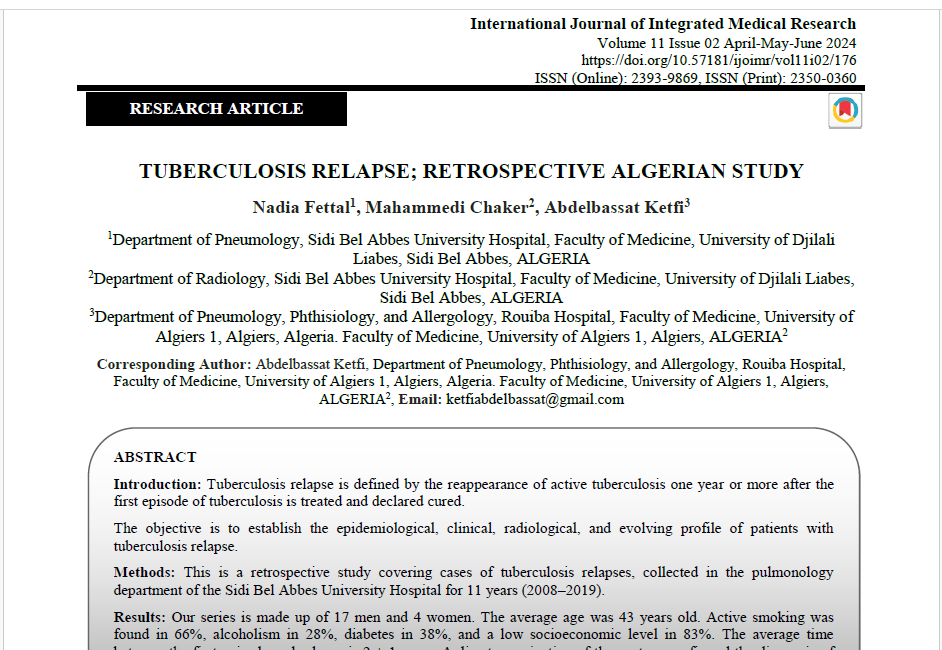Tuberculosis Relapse; Retrospective Algerian Study Tuberculosis Relapse
Main Article Content
Abstract
Introduction: Tuberculosis relapse is defined by the reappearance of active tuberculosis one year or more after the first episode of tuberculosis is treated and declared cured.
The objective is to establish the epidemiological, clinical, radiological, and evolving profile of patients with tuberculosis relapse.
Methods: This is a retrospective study covering cases of tuberculosis relapses, collected in the pulmonology department of the Sidi Bel Abbes University Hospital for 11 years (2008–2019).
Results: Our series is made up of 17 men and 4 women. The average age was 43 years old. Active smoking was found in 66%, alcoholism in 28%, diabetes in 38%, and a low socioeconomic level in 83%. The average time between the first episode and relapse is 2 ± 1 years. A direct examination of the sputum confirmed the diagnosis of tuberculosis. Radiologically, tuberculosis manifested itself as extensive excavated lung lesions in 45% of cases. The evolution was favorable in the majority of cases; however, there was resistance to anti-tuberculosis drugs in one case and one death following bilateral pneumothorax.
Conclusion: Tuberculous relapses are the prerogative of young smokers with poor social conditions. The seriousness lies above all in the risk of the emergence of resistance to anti-tuberculosis drugs.
Article Details
References
mondiale de la Santé O. Guide pratique de l'OMS sur la tuberculose: module 1: prévention: traitement préventif de la tuberculose. Guide pratique de l'OMS sur la tuberculose: module 1: prévention: traitement préventif de la tuberculose2021.
Falk A. Classification of pulmonary tuberculosis. Diagnostic standards and classification of tuberculosis. 1969:68-76.
Organization WH. World Health Organization Global Tuberculosis Report 2020. World Health Organization. 2020;232.
Millet J-P, Shaw E, Orcau À, Casals M, Miró JM, Caylà JA, et al. Tuberculosis recurrence after completion treatment in a European city: reinfection or relapse? Plos one. 2013;8(6):e64898.
Dobler CC, Crawford AH, Jelfs PJ, Gilbert GL, Marks GB. Recurrence of tuberculosis in a low-incidence setting. European Respiratory Journal. 2009;33(1):160-7.
Organization WH. Strategic plan for the prevention and control of multidrug-resistant and extensively drug-resistant tuberculosis in the Eastern Mediterranean Region [2010-2015]. 2010.
Mjid M, Hedhli A, Zakhma M, Zribi M, Ouahchi Y, Toujani S, et al. Profil clinique et microbiologique des patients en situation de rechute tuberculeuse en Tunisie. Revue de Pneumologie clinique. 2018;74(2):76-80.
Majdaoui H. L'association tuberculose pulmonaire et diabète. 2016.
Lambert M-L, Hasker E, Van Deun A, Roberfroid D, Boelaert M, Van der Stuyft P. Recurrence in tuberculosis: relapse or reinfection? The Lancet infectious diseases. 2003;3(5):282-7.
Cerezales MS, Elorza EN. Tuberculosis in special populations. Enfermedades Infecciosas y Microbiología Clínica. 2011;29:20-5.
Caylà JA, Orcau A. Control of tuberculosis in large cities in developed countries: an organizational problem. BMC medicine. 2011;9:1-5.
Chiang C-Y, Riley LW. Exogenous reinfection in tuberculosis. The Lancet infectious diseases. 2005;5(10):629-36.
Andrews JR, Noubary F, Walensky RP, Cerda R, Losina E, Horsburgh CR. Risk of progression to active tuberculosis following reinfection with Mycobacterium tuberculosis. Clinical Infectious Diseases. 2012;54(6):784-91.
Barnes PF, Cave MD. Molecular epidemiology of tuberculosis. New England journal of medicine. 2003;349(12):1149-56.
Jagielski T, Minias A, van Ingen J, Rastogi N, Brzostek A, Żaczek A, et al. Methodological and clinical aspects of the molecular epidemiology of Mycobacterium tuberculosis and other mycobacteria. Clinical microbiology reviews. 2016;29(2):239-90.
Vega V, Rodríguez S, Van der Stuyft P, Seas C, Otero L. Recurrent TB: a systematic review and meta-analysis of the incidence rates and the proportions of relapses and reinfections. Thorax. 2021;76(5):494-502.
Sonnenberg P, Murray J, Glynn JR, Shearer S, Kambashi B, Godfrey-Faussett P. HIV-1 and recurrence, relapse, and reinfection of tuberculosis after cure: a cohort study in South African mineworkers. The lancet. 2001;358(9294):1687-93.
Shen G, Xue Z, Shen X, Sun B, Gui X, Shen M, et al. Recurrent tuberculosis and exogenous reinfection, Shanghai, China. Emerging infectious diseases. 2006;12(11):1776.
Marx FM, Dunbar R, Enarson DA, Williams BG, Warren RM, Van Der Spuy GD, et al. The temporal dynamics of relapse and reinfection tuberculosis after successful treatment: a retrospective cohort study. Clinical Infectious Diseases. 2014;58(12):1676-83.
Shao Y, Song H, Li G, Li Y, Li Y, Zhu L, et al. Relapse or re-infection, the situation of recurrent tuberculosis in eastern China. Frontiers in cellular and infection microbiology. 2021;11:638990.
Jimenez-Corona M-E, Garcia-Garcia L, DeRiemer K, Ferreyra-Reyes L, Bobadilla-del-Valle M, Cano-Arellano B, et al. Gender differentials of pulmonary tuberculosis transmission and reactivation in an endemic area. Thorax. 2006;61(4):348-53.
Soomro JA, Qazi HA. Factors associated with relapsed tuberculosis in males and females: a comparative study. TANAFFOS (Respiration). 2009;8(3 (summer)):22-7.
Kim L, Moonan P, Yelk Woodruff R, Kammerer J, Haddad M. Epidemiology of recurrent tuberculosis in the United States, 1993–2010. The International Journal of Tuberculosis and Lung Disease. 2013;17(3):357-60.
Brugueras S, Molina V-I, Casas X, González Y-D, Forcada N, Romero D, et al. Tuberculosis recurrences and predictive factors in a vulnerable population in Catalonia. Plos one. 2020;15(1):e0227291.
Thomas A, Gopi P, Santha T, Chandrasekaran V, Subramani R, Selvakumar N, et al. Predictors of relapse among pulmonary tuberculosis patients treated in a DOTS programme in South India. The International Journal of Tuberculosis and Lung Disease. 2005;9(5):556-61.
Underner M, Perriot J. Tabac et tuberculose. La Presse Médicale. 2012;41(12):1171-80.
Hanson L, Korotkova M, Telemo E. Human milk: Its components and their immunobiologic functions. Mucosal Immunology. 2005:1795-827.
Consortium TT. Rifapentine and isoniazid once a week versus rifampicin and isoniazid twice a week for treatment of drug-susceptible pulmonary tuberculosis in HIV-negative patients: a randomised clinical trial. The lancet. 2002;360(9332):528-34.
Nissapatorn V, Kuppusamy I, Jamaiah I, Fong MY, Rohela M, Anuar AK. Tuberculosis in diabetic patients: a clinical perspective. The Southeast Asian journal of tropical medicine and public health. 2005;36(4):213-20.
Romanowski K, Balshaw RF, Benedetti A, Campbell JR, Menzies D, Khan FA, et al. Predicting tuberculosis relapse in patients treated with the standard 6-month regimen: an individual patient data meta-analysis. Thorax. 2019;74(3):291-7.
O'Toole RF, Shukla SD, Walters EH. TB meets COPD: An emerging global co-morbidity in human lung disease. Tuberculosis. 2015;95(6):659-63.
